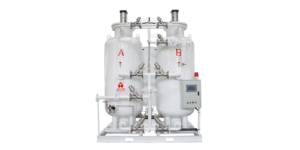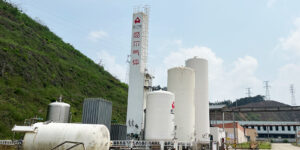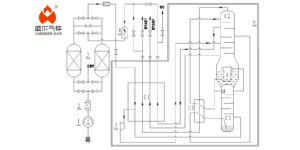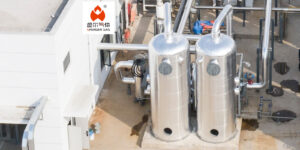In cryogenic Air Separation Unit, the key role in gas separation is played by the distillation towers. These distillation towers are mainly divided into two types: tray towers and packed towers. Each has its own characteristics in terms of operational requirements, equipment performance, equipment maintenance, and application scenarios.

Basic Principles of Tray Towers
Tray towers utilize mass and heat transfer between trays to separate mixed gases into pure components through the distillation process between gas and liquid.
During the distillation separation process in cryogenic air separation equipment. The gas mixture enters the top of the tray tower and descends layer by layer through the tower body. Within the tray tower, mass and heat transfer occur between gas and liquid. Causing gas components to gradually separate in the liquid based on their relative solubility. As the gas gradually cools from the top to the bottom of the tower, various components condense layer by layer and separate between the trays, thus achieving distillation.
Basic Principles of Packed Towers
Packed towers utilize the large surface area provided by packing. And the mass and heat transfer process between gas and liquid to achieve the separation and purification of mixed gases.
In the cryogenic air separation process, the gas mixture enters from the top of the packed tower and comes into contact with the packing inside the tower. The packing provides a large surface area where the gas forms a thin film on the surface, facilitating mass transfer and heat exchange with the liquid inside the tower. Consequently, gas components gradually separate in the liquid based on their solubility. As the gas cools progressively from the top to the bottom of the tower, various components condense layer by layer and separate between the packing, achieving the distillation effect.
Differences Between Tray Towers and Packed Towers
Tray towers and packed towers have different characteristics and advantages in terms of structure, mass and heat transfer efficiency, pressure drop and energy consumption, operational flexibility, and maintenance cleanliness.
| Category | Tray Towers | Packed Towers |
| Structure and Appearance | Comprised of a series of parallel trays with gaps between them, presenting a layered structure | Internally filled with various packing materials, presenting a uniformly filled appearance |
| Mass and Heat Transfer Efficiency | Small gaps between trays limit mass and heat transfer efficiency | Packing provides a large surface area, resulting in higher mass and heat transfer efficiency |
| Pressure Drop and Energy Consumption | Usually have small pressure drops and relatively low energy consumption | Usually have larger pressure drops, requiring relatively higher energy consumption |
| Operational Flexibility | Number of trays can be increased or decreased as needed | Types and forms of packing can be selected and adjusted as needed, offering high flexibility |
| Maintenance and Cleanliness | More trays in tray towers make cleaning and maintenance relatively complex | Relatively simple structure makes cleaning and maintenance easier |
How to Choose the Suitable Process Type
1、Operational Conditions and Requirements:
Packed towers are typically suitable for situations requiring high-efficiency mass and heat transfer. While tray towers are suitable for situations with higher separation efficiency requirements or relatively strict operational conditions.
2、Characteristics of Mixed Gases:
Analyze the composition of the mixed gases, relative solubility, and mass and heat transfer characteristics. Then determine which tower type is more suitable for effective gas separation and purification.
3、Equipment Investment and Operating Costs:
Packed towers typically have lower equipment investment costs but may require more energy consumption. While tray towers may have higher equipment investment costs but relatively lower energy consumption.
4、Operational Flexibility and Maintenance Requirements:
Packed towers usually have strong operational flexibility, are easy to adjust and maintain, while tray towers may have higher separation efficiency in certain situations but relatively complex maintenance and cleaning requirements.
Both tray towers and packed towers are effective for various separation processes. The choice between the two depends on factors such as the required separation, flow rate, fluid characteristics, and cost considerations. By understanding the design principles and considerations discussed in this article, you can make informed decisions and optimize the performance of the separation process.








